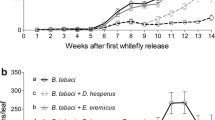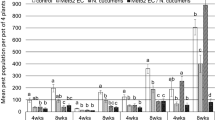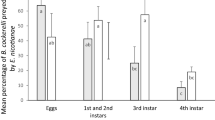Abstract
The effects of intraguild interactions between Dicyphus hesperus Knight (Hemiptera: Miridae) and Paecilomyces fumosoroseus Apopka-97 (PFR-97TM) (Wize) Brown and Smith (Ascomycota: Hypocreales) on Trialeurodes vaporariorum (Westwood) (Hemiptera: Aleyrodidae) populations were investigated in tomato greenhouse microcosms. Conditions were established in which interference or synergy would most likely occur; namely, a high number of available whiteflies were combined with large numbers of both D. hesperus and PFR-97TM. We measured live whitefly density in a factorial repeated measures experiment where plants were provided or withheld releases of D. hesperus and/or applications of PFR-97TM for 6 weeks. Releases of D. hesperus were made at a rate of 10 adults/plant during the first and third week and PFR-97TM suspensions were applied with a backpack sprayer at a rate of 18 × 107, 1.3 × 107 and 1.2 × 107 viable blastospores/ml during the first, third and fourth week, respectively. Results revealed a non-significant interaction effect between D. hesperus and PFR-97TM, indicating that their actions were independent. Individual whitefly reductions of 48% and 35% were achieved by PFR-97TM and D. hesperus, respectively. Collectively, the natural enemies reduced whitefly densities by 62% relative to the controls. The density of D. hesperus adults was unaffected by multiple applications of PFR-97TM. These results suggest that the combination of generalist entomopathogenic fungi and generalist predators has the potential to cause increased pest mortality despite evidence of minimal interference.
Similar content being viewed by others
References
Albajes R., Alomar O., Riudavets J., Castañé C., Arnó J., Gabarra R. (1996) The mirid bug Dicyphus tamaninii: an effective predator for vegetable crops. IOBC/WPRS Bull. 19(1):1–4
Bolckmans K., Sterk G., Eyal J., Sels B., Stepman W.(1995) PreFeRal, (Paecilomyces fumosoroseus (Wize) Brown and Smith, strain Apopka 97), a new microbial insecticide for the biological control of whiteflies in greenhouses. Med. Fac. Landbouww. Univ. Gent. 60:707–711
Faria M., Wraight S.P. (2001) Biological control of Bemisia tabaci with fungi. Crop Prot. 20:767–778
Ferguson K.I., Stiling P.(1996) Non-additive effects of multiple natural enemies on aphid populations. Oecologia 108:375–379
Fransen J.J., van Lenteren J.C. (1993) Host selection and survival of the parasitoid Encarsia formosa on greenhouse whitefly, Trialeurodes vaporariorum, in the presence of hosts infected with the fungus Aschersonia aleyrodis. Entomol. Exp. Appl. 69:239–249
Fransen J.J., van Lenteren J.C. (1994) Survival of the parasitoid Encarsia formosa after treatment of parasitized greenhouse whitefly larva with fungal spores of Aschersonia aleyrodis. Entomol. Exp. Appl. 71:235–243
Goettel M.S., Poprawski T.J., Vandenberg J.D., Li Z., Roberts D.W. (1990) Safety to nontarget invertebrates of fungal biocontrol agents. In: Lard M., Lacey L.A., Davidson E.W. (eds) Safety of Microbial Insecticides. CRC Press, Florida, pp. 209–231
Goettel, M.S., Inglis G.D. (1997) Fungi: Hyphomycetes. In: Lacey L.A. (eds) Manual of techniques in insect pathology. Academic Press, London, pp. 213–249
Malais, M.H. and W.J. Ravensberg, 2003. Knowing and Recognizing: the biology of glasshouse pests and their natural enemies. Koppert B.V. Systems and Reed Business Information, The Netherlands. pp. 51–81
McGregor R.R, Gillespie D.R., Quiring D.M.J., Foisy M.R.J. (1999) Potential use of Dicyphus hesperus Knight (Heteroptera: Miridae) for biological control of pests of greenhouse tomatoes. Biol. Control 16:104–110
Meekes E.T.M., Fransen J.J., van Lenteren J.C. (2002) Pathogenicity of Aschersonia spp. against whiteflies Bemisia argentifolii and Trialeurodes vaporariorum. J. Invertebr. Pathol. 81:1–11
Osborne L.S., Landa Z. (1992) Biological control of whiteflies with entomopathogenic fungi. Florida Entomol. 75:456–471
Polis G.A., Holt R.D. (1992) Intraguild predation: The dynamics of complex trophic interactions. Trends Ecol. Evol. 7:151–154
Poprawski T.J., Legaspi J.C., Parker P.E. (1998) Influence of entomopathogenic fungi on Serangium parcesetosum (Coleoptera: Coccinellidae), an important predator of whiteflies (Homoptera: Aleyrodidae). Environ. Entomol. 27:785–795
Poprawski T.J., Greenberg S.M., Ciomperlik M.A. (2000) Effect of host plant on Beauveria bassiana- and Paecilomyces fumosoroseus- induced mortality of Trialeurodes vaporariorum (Homoptera: Aleyrodidae). Environ. Entomol. 29:1048–1053
Roy H.E., Pell J.K., Clark S.J., Alderson P.G. (1998) Implications of predator foraging on aphid pathogen dynamics. J. Invertebr. Pathol. 71:236–247
Roy H.E., Pell J.K. (2000) Interactions between entomopathogenic fungi and other natural enemies: implications for biological control. Biocontrol Sci. Technol. 10:737–752
Sampson A.C., King V.C. (1996) Macrolophus caliginosus, field establishment and pest control effect in protected tomatoes. IOBC/WPRS Bull. 19 (1):143–146
Sanchez J.A., Gillespie D.R., McGregor R.R. (2003) The effects of mullein plants (Verbascum thapsus) on the population dynamics of Dicyphus hesperus (Heteroptera: Miridae) in tomato greenhouses. Biol. Control 28:313–319
Sterk G., Bolckmans K., Van de Veire M., Sels B., Stepman W. (1995) Side-effects of the microbial insecticide PreFeRal (Paecilomyces fumosoroseus (Wize) Brown and Smith, strain Apopka 97) on different species of beneficial arthropods. Med. Fac. Landbouww. Univ. Gent. 60:719–723
Van de Veire M., Degheele D. (1996) Toxicity of the fungal pathogen Paecilomyces fumosoroseus strain Apopka 97 to the greenhouse whitefly Trialeurodes vaporariorum and the parasitoid Encarsia formosa, and the first results of a control experiment in glasshouse tomatoes. IOBC/WPRS Bull. 19(1):191–194
van Lenteren J.C., van Roermund H.J.W., Sütterlin S. (1996) Biological control of greenhouse whitefly (Trialeurodes vaporariorum) with the parasitoid Encarsia formosa: How does it work? Biol. Control 6:1–10
van Lenteren J.C., Drost Y.C., van Roermund H.J.W., Posthuma-Doodeman C.J.A.M. (1997) Aphelinid parasitoids as sustainable biological control agents in greenhouses. J. Appl. Entomol. 121:473–485
Acknowledgements
This work was supported by the NSERC Biocontrol Network, Agriculture and Agri-Food Canada (AAFC), and the British Columbia Greenhouse Research Council. We would like to thank Ian Bercovitz for his assistance with the statistical analyses. We are very grateful to Jasmin Gee for her assistance with the collection of experimental data and to Randy Thompson for his periodic assistance. The commercial formulation PFR-97TM was provided by Certis USA, Columbia MD.
Author information
Authors and Affiliations
Corresponding author
Rights and permissions
About this article
Cite this article
Alma, C.R., Goettel, M.S., Roitberg, B.D. et al. Combined effects of the entomopathogenic fungus, Paecilomyces fumosoroseus Apopka-97, and the generalist predator, Dicyphus hesperus, on whitefly populations. BioControl 52, 669–681 (2007). https://doi.org/10.1007/s10526-006-9053-1
Received:
Accepted:
Published:
Issue Date:
DOI: https://doi.org/10.1007/s10526-006-9053-1




